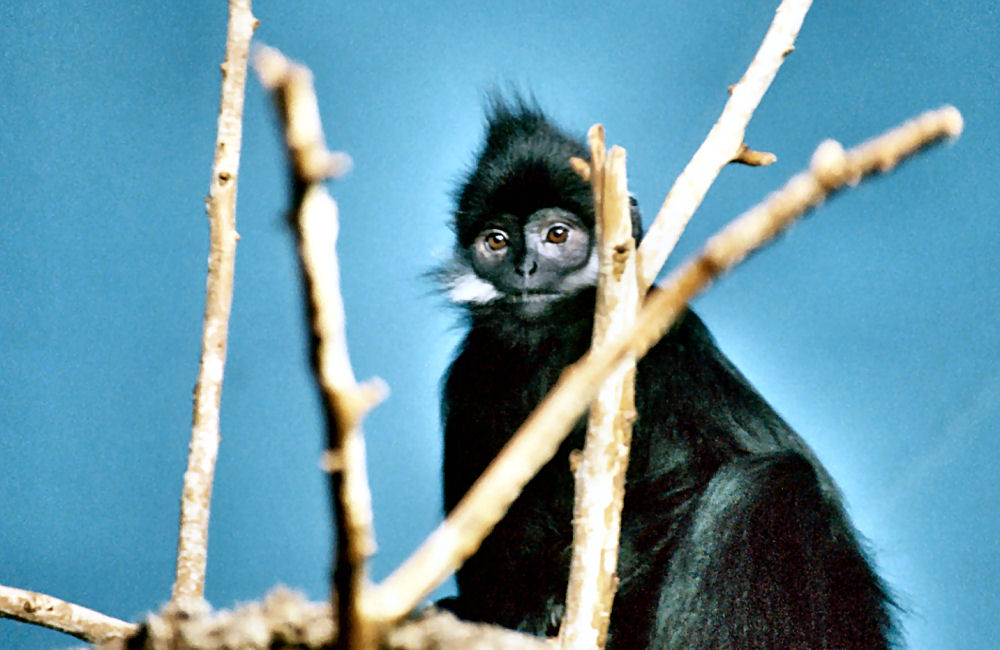- Lutung
Taxobox
name = Lutungs

image_width = 220px
image_caption =Francois' Langur ("Trachypithecus francoisi")
regnum =Animal ia
phylum =Chordata
classis =Mammal ia
ordo =Primate s
familia =Cercopithecidae
subfamilia =Colobinae
genus = "Trachypithecus"
genus_authority = Reichenbach, 1862
type_species = "Semnopithecus pyrrhus"
type_species_authority = Horsfield, 1823
(= "Cercopithecus auratus" É. Geoffroy, 1812)
subdivision_ranks =Species
subdivision = 17, see textThe lutungs are a group of
Old World monkey s and make up the entirety of thegenus "Trachypithecus". Their range is split into two parts; one part is much of southeastAsia (northeastIndia , southernChina ,Borneo ,Thailand ,Java andBali ), the other part is extreme southern India andSri Lanka . The majority of India has no lutungs. Most of the species in this genus can be referred to as lutungs, aslangur s, or asleaf monkey s.Lutungs have a rather slim build with a long tail. The fur coloring varies depending upon species from black and grey to orange yellow. Many species have skin designs and a brighter lower surface, the hair on the head are often compared to a hood. Their arms are very short in comparison to the feet and their thumbs are also somewhat shorter. The inner surfaces of the hands and feet are hairless so that their fur doesn't get caught when reaching into branches. These animals reach a length of 40 to 80 cm and a weight of 5 to 15 kg, with males generally larger than females. A bulge over the eyes and other details, primarily in the head, differentiate it from the
surili s.Lutungs live in the forests, often preferring rain forests although occasionally they are also found in secluded mountain forests. They spend the largest part of the day in the trees, where they crawl along the branches on all fours, although they can also jump well from tree to tree. They are diurnal, although more active in the early mornings and the afternoon.
They live in groups of 5 to 20 animals, mostly in
harem s, i.e. a single male with several females. Young males must leave their birth group when fully mature, often forming bachelor groups. If a new male takes over a harem, defeating and scaring off the harem leader, it often kills the children of the group. Lutungs are territorial, with loud shouting to defend their territory from other lutung interlopers, resorting to force if the outsiders aren't scared off. They have a common repertoire of sounds with which they warn group members. Also, mutual grooming plays an important role.Lutungs are
herbivore s, primarily eating leaves, fruits and buds. In order to digest the hard leaves, they developed a multichambered stomach.Rarely twins, a typical single birth comes after a seven month gestation period. Newborns usually have a golden-yellow fur. The mother shares responsibilities of rearing the young with the other females ("aunties") of the harem. They hand the young around, play with it, carry it and cuddle it, while the mother searches for food. If the mother dies, another female adopts the young animal. Lutungs are weaned in the latter half of their first year, and reach full maturity at 4 to 5 years. The life expectancy is estimated at 20 years.
pecies
* Genus "Trachypithecus"
** "T. vetulus" group
***Purple-faced Langur , "Trachypithecus vetulus"
***Nilgiri Langur , "Trachypithecus johnii"
** "T. cristatus" group
***Javan Lutung , "Trachypithecus auratus"
***Silvery Lutung or Silvered Leaf Monkey, "Trachypithecus cristatus"
***Indochinese Lutung , "Trachypithecus germaini"
***Tenasserim Lutung , "Trachypithecus barbei"
** "T. obscurus" group
***Dusky Leaf Monkey , "Trachypithecus obscurus"
***Phayre's Leaf Monkey , "Trachypithecus phayrei"
** "T. pileatus" group
***Capped Langur , "Trachypithecus pileatus"
***Shortridge's Langur , "Trachypithecus shortridgei"
***Gee's Golden Langur , "Trachypithecus geei"
** "T. francoisi" group
***Francois' Langur , "Trachypithecus francoisi"
***Hatinh Langur , "Trachypithecus hatinhensis"
***White-headed Langur , "Trachypithecus poliocephalus"
***Laotian Langur , "Trachypithecus laotum"
***Delacour's Langur , "Trachypithecus delacouri"
***Indochinese Black Langur , "Trachypithecus ebenus"References
*MSW3 Groves|pages=175-178
External links
* [http://pin.primate.wisc.edu/factsheets/links/trachypithecus Primate Info Net "Trachypithecus" Factsheets]
Wikimedia Foundation. 2010.
